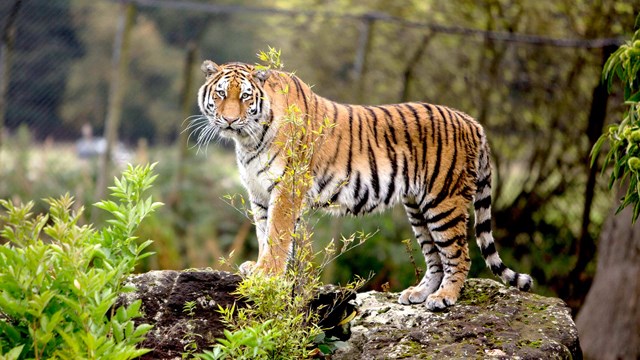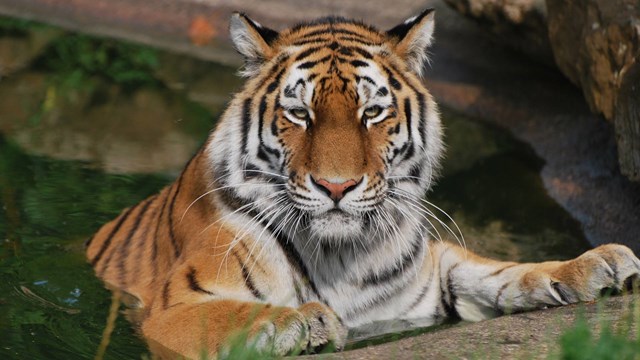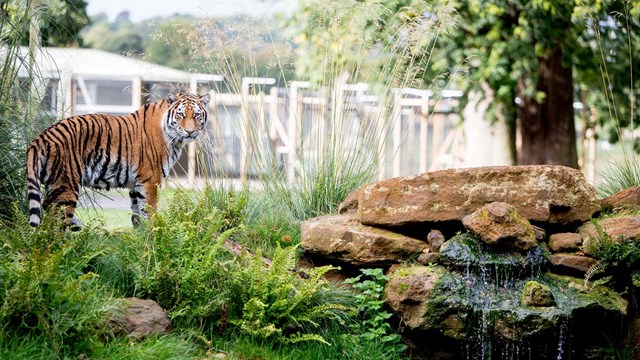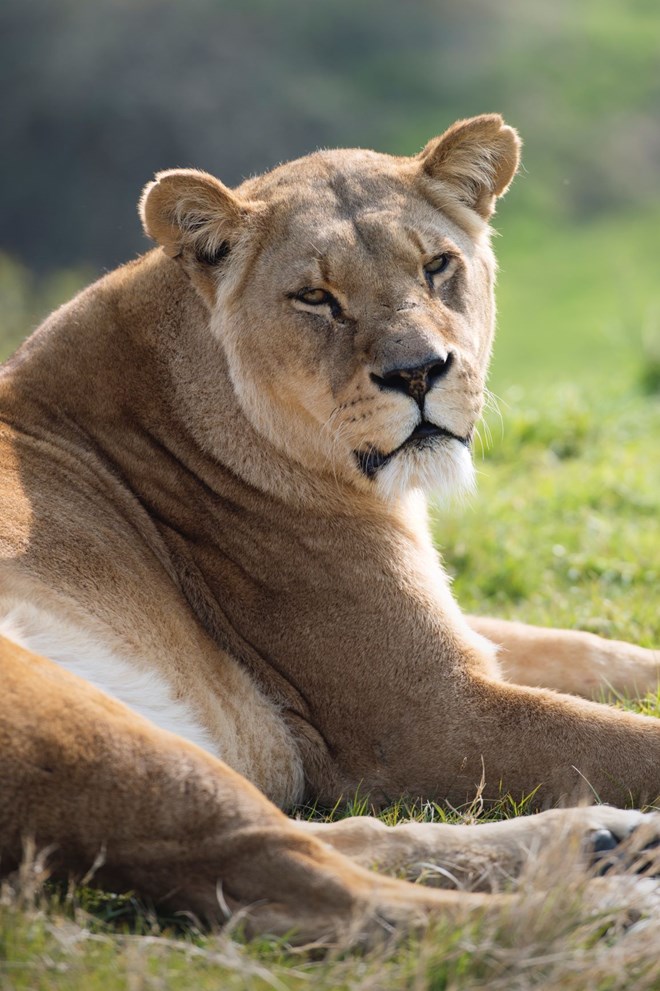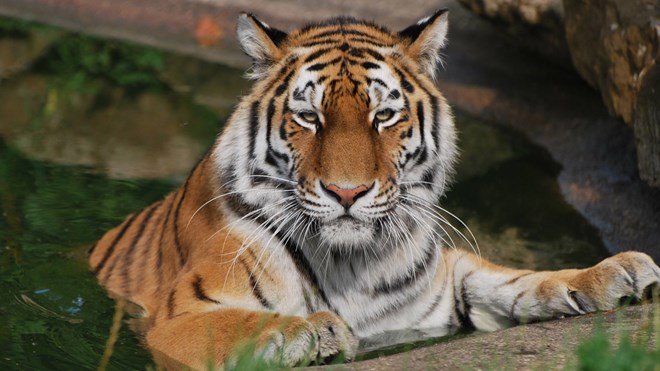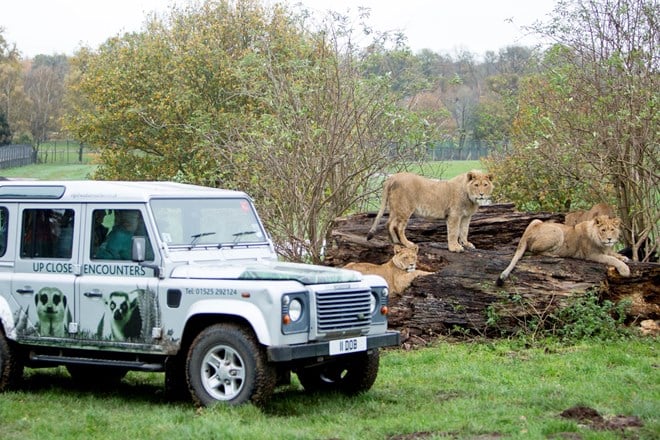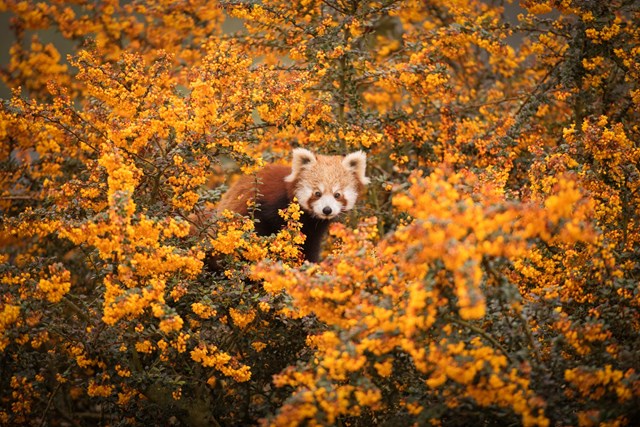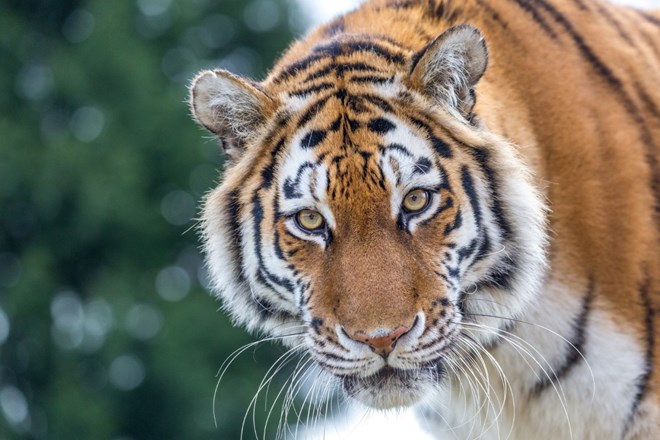
Overview
Woburn Safari Park is home to one female Amur tiger called Minerva and one male called Dmitri. The pair live in the Kingdom of the Carnivores in a secure area, giving them nine acres to roam, including shady areas for the height of summer and a house with an overnight space.
Minerva was born in October 2011 and arrived at the Park in 2013. Dmitri was born in 2018 and arrived at the Park just three days before his fourth birthday in 2022.
Tigers are naturally solitary animals, meaning they live alone, with the exception of mothers and their young cubs. Young tigers become independent from their mothers at around 17-24 months old.
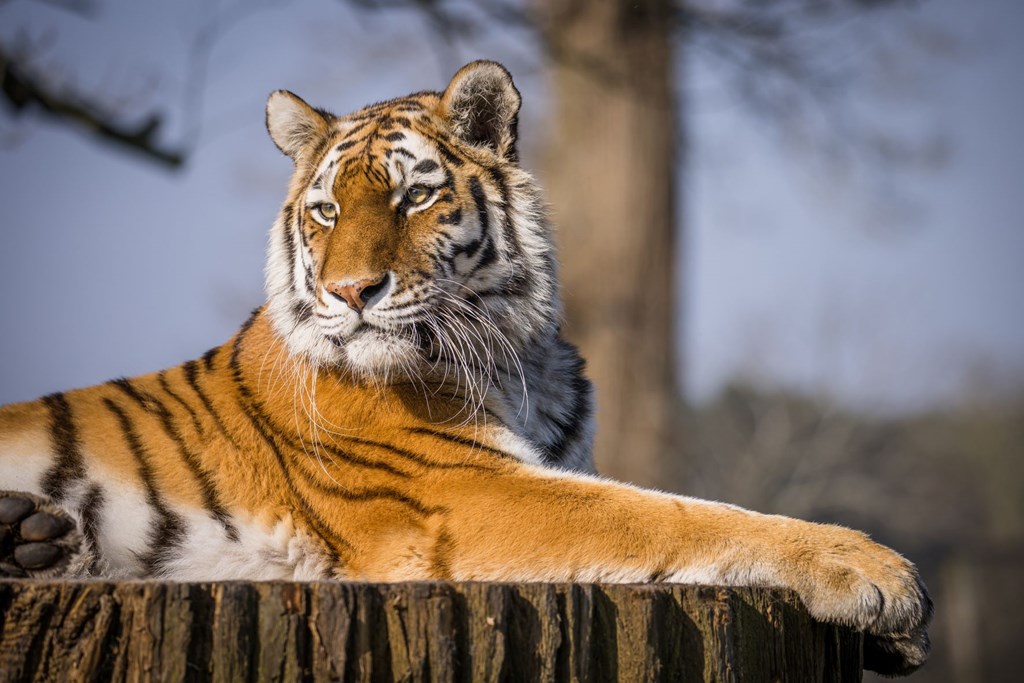
All about us
| Distribution: | Eastern Russia |
|---|---|
| Habitat: | Birch Forests |
| Height: | Length: 10.75ft (3.3.m) |
| Weight: | 165 - 300kg |
| Gestation Period: | 100 days |
| Lifespan: | 8 to 15 years in the wild |
| Threats: | Hunting, poaching and habitat loss |
Scientific name: Panthera tigris altaica
Amur tigers (from a region of Siberia) are the largest of the big cat species and are renowned for their power and strength. There are only an estimated 400 to 500 Amur tigers living in the wild, in the birch forests of Eastern Russia. These powerful hunters travel many miles to find prey, such as elk and wild boar on nocturnal hunts. Tigers use their distinctive coats as camouflage (no two tigers have exactly the same stripes) and hunt by stealth. A hungry tiger can eat as much as 60 pounds (27 kilograms) in one night.

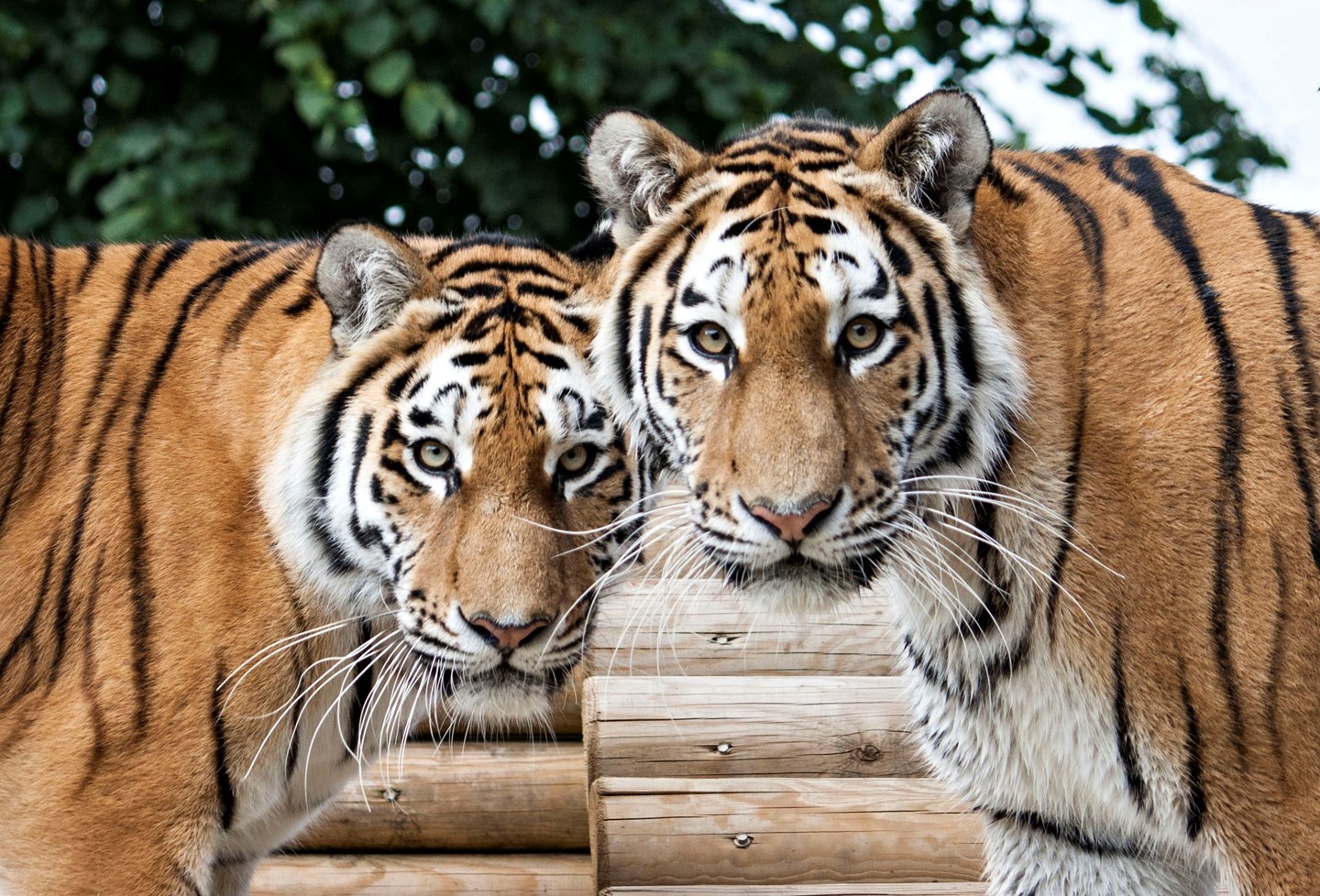
Tiger Endangered Breeding Programme
Coordinated breeding is incredibly important in ensuring the future survival of the species as a whole.
To ensure a sustainable future for the species, breeding is controlled by a Studbook Keeper. Records are kept of every Amur tiger in captivity, including their history, bloodline, parents, siblings, and movements between wildlife collections. Decisions on breeding are based on the recommendation of the studbook keeper, to ensure the strongest genetic match is made, within the captive population.
Minerva is ranked as one of the most important females in the captive tiger population in Europe. She has already successfully reared cubs at Woburn that have now moved on to other collections and had cubs of their own, continuing this important bloodline.
Amur tiger facts
Each tiger has a unique patterned coat which provides camouflage while hunting. Like the human fingerprint, no two coats are the same. A tigers coat consists of two layers; the longer outer fur layer of guard hair which provides camouflage and protects against the elements. The under fur layer provides insulation, keeping the tiger warm in harsh winter weather.
Tigers can often be seen in the wild scratching their claws against trees to keep them sharp. Claws are retractable to keep them sharp enough to grip into their prey during hunting. Also, when claws are retracted it allows the tiger to pick up speed during the chase.
Tigers in general are the largest of the big cat (Panthera) species but the Amur tiger is the largest sub species. Ranging from 45kgs to over 300kgs, males tend to be heavier and taller than the females. The longest ever recorded tiger was measured at 11 feet in length! Their very long tail accounts for around 3 feet of the overall length.
Tigers’ eyesight is comparable to a human’s during the day, however at night their abilities are six times better. This definitely makes it much easier for them to sneak up on their prey. The design of their eyes allows them to see so much better at night. They have larger pupils and lenses than those in a human eye.
Many omniverous carnivores like bears have 40-42 teeth, but the tiger has only 30. Their lower jaw only moves up and down (with no side to side movement like a human's), and has a powerful grip to hold struggling prey. As a tiger ages, their teeth can wear out, which can lead to starvation.
Tigers are naturally solitary animals, unless it is a female with cubs. They will roam miles for prey and can be territorial, scent marking trees and calling to warn off others away from their territory.
Tigers are very majestic with their movements, they are very light on their feet, allowing them to creep up on their prey; taking advantage of the element of surprise!
Unlike other feline species, they like water and are extremely strong swimmers. This is a great method for cooling down during hot weather.
Strong powerful limbs allow them to move at great speed when required, with the potential to move at bursts of speed of up to 40 mph, but only for short bursts.
When a female comes into oestrus (the receptive state for breeding) she produces a distinctive smell caused by specific urinary glands secretion. The female can also become vocal, calling to attract the attention of nearby males. She will roar or make moaning sounds and if a male hears the call, he may choose to respond.
Tigers will become sexually mature around 4-5 years of age and produce a litter with an average of 2-3 cubs. They will only pair up to breed and will then go their separate ways afterwards. In their lifetime a male and female can have several partners.
Tigers in captivity cannot hunt their own food as they would in the wild, so it’s important for keepers to encourage animals to use the energy they would normally expend during hunting on other activities. Keeping skin and bones on meat ensures a tougher task during feeding.
Not every attempt at hunting in the wild is successful, so providing starve days in captivity to replicate their natural gorge / fast feed pattern.
Tigers at Woburn Safari Park are fed every 3 days and meat is presented in a variety of ways to keep the animals’ interest keen. Keepers chain the meat to trees to replicate the struggle or fight of bringing prey to ground. They also place it higher up on feed poles, forcing tigers to exert more energy to feed.
Encouraging natural behaviour in captive animals through these methods is called ‘enrichment’. In the wild tigers would come across the scent of numerous other animals in their territory. Keepers therefore introduce differents fragrances, including lavender, perfumes and other animal feces within the enclosure. At Woburn, the enclosure has water pools, giving the tigers access to water for bathing.
All big cats, including tigers are carnivores and therefore have an all meat diet. Tigers will tend to gorge at their feed and can eat up to 18 kilos in one sitting. This will be enough food for three to four days. Their diet in the wild can consist of wild boar and various species of deer; if food sources are scarce they will also resort to eating rodents and small birds.
Amur tigers face a number of threats, all of which result from conflict with humans. The main threat is poaching. Tigers are surrounded by myths and in some cultures it is mistakenly believed their bones, claws, teeth and other body parts provide healing benefits. As a result, tigers’ body parts are extremely valuable on the black market. Tiger skin is also popular in the fur trade industry.
Tiger populations are under threat due to loss of habitat. As more and more land is claimed by humans for urban and agricultural use, tiger territories are reduced and their food sources are affected. Whether land is flattened for new buildings or claimed for farming, tigers are forced into new areas that might not provide a sustainable food sources. Some tigers will remain in their original territory, in areas converted for farming livestock they are at most risk from farmers looking to protect their herds.
Conservation projects are either undertaken ‘in-situ’ (in tigers own habitat) e.g. India or Asia, or ‘ex-situ’ (outside of their habitat) eg. in zoos and safari parks. Conservation efforts will usually start with education. Efforts will be made to improve understanding of why tigers are endangered and how they can be helped. Conservation projects around the world include ‘Born Free’, the World Wildlife Fund (WWF) and ‘Tiger Awareness’, and these aim to work in situ with local governments, to provide education of how humans can live alongside tigers.
Ex-situ programs in zoos and safari parks focus on captive breeding programs. To ensure a sustainable future for the species, breeding is controlled by a Studbook Keeper. Records are kept of every Amur tiger in captivity, including their history, bloodline, parents, movements between collections and their siblings. Decisions on breeding will be based on the recommendation of the studbook keeper, to ensure the strongest match is made within the captive population.
Tigers are reliant on large contiguous expanses of forest habitat, with access to prey, water and undisturbed areas of land in which to breed. Without education in these localities, promoting essential conservation projects, this beautiful species’ future in the wild becomes increasingly uncertain.
